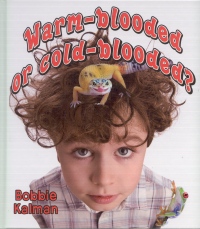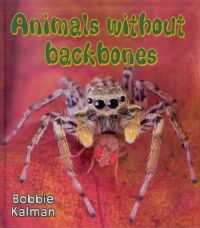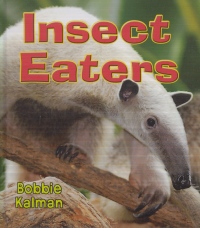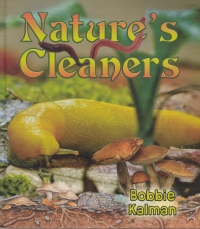| ________________
CM . . . . Volume XV Number 17. . . .April 17, 2009. 
 |
Warm-blooded or Cold-blooded. (Big Science Ideas).
Bobbie Kalman.
St. Catharines, ON: Crabtree, 2009.
32 pp., pbk. & hc., $9.95 (pbk.), $20.76 (hc.).
ISBN 978-0-7787-3301-0 (pbk.), ISBN 978-0-7787-3281-5 (RLB).
Subject Headings:
Body temperature-Juvenile literature.
Body temperature-Regulation-Juvenile literature.
Grades 1-4 / Ages 6-9.
Review by Barbara McMillan.
***/4
|
| |
|

 |
Animals Without Backbones. (Big Science Ideas).
Bobbie Kalman.
St. Catharines, ON: Crabtree, 2009.
32 pp., pbk. & hc., $9.95 (pbk.), $20.76 (hc.).
ISBN 978-0-7787-3399-0 (pbk.), ISBN 978-0-7787-3279-2 (RLB).
Subject Heading:
Invertebrates-Juvenile literature.
Grades 1-4 / Ages 6-9.
Review by Barbara McMillan.
***/4
|
| |
|

 |
Insect Eaters. (Big Science Ideas).
Bobbie Kalman.
St. Catharines, ON: Crabtree, 2009.
32 pp., pbk. & hc., $9.95 (pbk.), $20.76 (hc.).
ISBN 978-0-7787-3298-3 (pbk.), ISBN 978-0-7787-3278-5 (RLB).
Subject Headings:
Animals-Food-Juvenile literature.
Insectivores (Mammals)-Juvenile literature.
Grades 1-4 / Ages 6-9.
Review by Barbara McMillan.
***/4
|
| |
|

 |
Nature’s Cleaners. (Big Science Ideas).
Bobbie Kalman.
St. Catharines, ON: Crabtree, 2009.
32 pp., pbk. & hc., $9.95 (pbk.), $20.76 (hc.).
ISBN 978-0-7787-3300-3 (pbk.), ISBN 978-0-7787-3280-8 (RLB).
Subject Headings:
Biodegradation-Juvenile literature.
Scavengers (Zoology)-Juvenile literature.
Grades 1-4 / Ages 6-9.
Review by Barbara McMillan.
***/4
|
| |
|

excerpt:
Many insects have wings. Some insects have one pair of wings. Other insects have two pairs of wings. Insects with wings can fly. Insects are the only invertebrates that can fly. (From Animals Without Backbones.)
Spiders are small animals with eight legs. They are not insects, but they like to eat insects! Spiders eat flies, moths, and other prey. Prey are animals that predators hunt. The jumping spider [illustrated] is a predator. The fly is its prey. (From Insect Eaters.)
When living things die, they still have energy and nutrients in their bodies. The leftover energy and nutrients are used by other living things. Nothing is wasted in nature! Living things that eat dead things help clean the Earth. (From Nature’s Cleaners.)
Bobbie Kalman is one of the most prolific writers of well-illustrated and clearly written science and social studies books for children. The four books in her new series, “Big Science Ideas,” will not disappoint her readers. Warm-blooded or Cold-blooded introduces children to animals that keep their internal body temperature constant and to animals that use external sources of heat, such as the Sun’s radiation, becoming whatever the fluctuating temperature of their surroundings may be. In Animals Without Backbones, children are introduced to vertebrates and invertebrates and helped to identify the amazing variety of animals without backbones that inhabit the planet’s water, air, and soil. Insect Eaters exposes readers to the animals and insectivorous plants (like the Venus flytrap) that acquire their energy and nutrients from a diet composed primarily of an assortment of insect prey. Scavengers, detrivores, and decomposers are the focus of Nature’s Cleaners. Children who have access to this book will learn about the scavenging animals that eat what carnivores leave behind, the smaller animals that clean up the skin, hair, bones, feces, and plant detritus that the scavengers are unable to digest, and the bacteria and fungi that break down all dead matter so that the chemical elements again become available to living organisms.
Each book in the “Big Science Ideas” series is illustrated with photographs that portray many of the concepts introduced in the text. In Nature’s Cleaners, for example, readers are shown the pair of antennae, the foot, and the radula of snails and slugs, two of nature’s detrivores, and are told the function of each one of these body parts. There is no need to imagine or guess what Kalman means when she uses scientific terminology or introduces a particular organism.
Of the four books in the series, Warm-blooded or Cold-blooded? is most focused on the child. This is a consequence of the questions posed. It’s as if Kalman is sitting with the child who is reading the book when she asks, “Are people warm-blooded or cold-blooded? Turn the page if you do not know” (p. 5). Again on page 11, following an explanation for why warm-blooded animals shiver or huddle together when they are cold, she asks, ”What other ways do you use to warm your body?” Finally on page 16, she writes, “What kind of clothes do you wear in winter? Do you wear a warm coat with a hood? Just as you need to keep warm, warm-blooded animals that live in cold places also need to keep warm. Animals do not wear clothes, so how do they keep warm?” She is asking the reader to think before an explanation or answer is provided. It would be wonderful if these questions were like the questions a scientist would ask, and if
such questions were posed more frequently in all four books. Not only would children be learning about the natural world, they would be learning how to think and ask questions like a scientist.
Recommended.
Barbara McMillan is a teacher educator and a professor of science education in the Faculty of Education, the University of Manitoba.

To comment on this title or this review, send mail to
cm@umanitoba.ca.
Copyright © the Manitoba Library Association. Reproduction for personal use is permitted only if this copyright notice is maintained. Any other reproduction is prohibited without permission.
NEXT REVIEW |
TABLE OF CONTENTS FOR THIS ISSUE- April 17, 2009.
AUTHORS |
TITLES |
MEDIA REVIEWS |
PROFILES |
BACK ISSUES |
SEARCH |
CMARCHIVE |
HOME |



